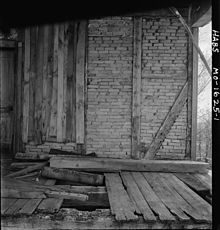Brick nog


Brick nog (nogging or nogged,[1] beam filling) is a construction technique in which bricks are used to fill the vacancies in a wooden frame. Such walls may then be covered with tile, weatherboards, or rendering, or the brick may remain exposed on the interior or exterior of the building.
The technique was developed in England from the late 1400s to early 1500s, developing out of methods such as wattle and daub and lath and plaster construction, with the bricks being laid in horizontal courses or a herringbone pattern.
Brick used in this way is rarely mechanically fastened to the adjacent wood members, generally being held in place only by the mortar bonds and friction. It is an integral part of the building structure that can also serve as fireproofing, soundproofing, or the final exposed surface of the assembly.[2]
Generally, the term brick infill is used instead of nogging in half-timbered construction, and the word nog or noggin has also come to be used to describe timber bracing pieces between wall studs in timber frame construction.
References
[edit]- ^ "Nog", v. 2. Oxford English Dictionary Second Edition on CD-ROM (v. 4.0). Oxford University Press, 2009.
- ^ Biggs, D. T. (12 June 2005). "Brick Nogging: Investigation and Repair" (PDF). Canada Masonry Design Centre. Retrieved 5 July 2023.
Text is available under the CC BY-SA 4.0 license; additional terms may apply.
Images, videos and audio are available under their respective licenses.
